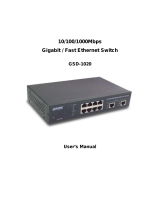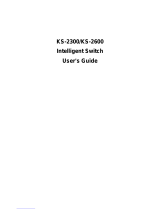
TABLE OF CONTENTS
1. INTRODUCTION.......................................................................................................................................1
1.1 CHECKLIST..............................................................................................................................................1
1.2 ABOUT THE SWITCH.................................................................................................................................1
1.3 FEATURES...............................................................................................................................................1
2. HARDWARE DESCRIPTION....................................................................................................................3
2.1 FRONT PANEL .........................................................................................................................................3
2.2 REAR PANEL...........................................................................................................................................4
2.3 HARDWARE INSTALLATION .......................................................................................................................5
3. SWITCH MANAGEMENT..........................................................................................................................7
3.1 OVERVIEW ..............................................................................................................................................7
3.2 MANAGEMENT METHODS.........................................................................................................................7
3.2.1 Local Console Management...........................................................................................................7
3.2.2 Remote Console Management.......................................................................................................8
3.2.3 Web Management..........................................................................................................................8
3.2.4 SNMP Management........................................................................................................................8
3.3 ASSIGNING AN IP ADDRESS TO THE SWITCH.............................................................................................8
3.4 LOGGING ON TO THE SWITCH...................................................................................................................8
4. CONSOLE INTERFACE............................................................................................................................9
4.1 CONNECT TO PC.................................................................................................................................9
4.2 LOGIN IN ...............................................................................................................................................10
4.3 MAIN SCREEN........................................................................................................................................10
4.3.1 Status and Counters.....................................................................................................................11
4.3.2 Switch Static Configuration...........................................................................................................13
4.3.3 Protocol Related Configuration....................................................................................................33
4.3.4 Reboot Switch...............................................................................................................................44
4.3.5 Command Line.............................................................................................................................46
4.3.6 Logout...........................................................................................................................................46
5. WEB MANAGEMENT..............................................................................................................................47
5.1 LOGIN IN TO THE SWITCH.......................................................................................................................47
5-2 PORT STATUS.......................................................................................................................................48
5-3 PORT STATISTICS..................................................................................................................................49
5-4 ADMINISTRATOR....................................................................................................................................50
5.4.1 IP Address....................................................................................................................................51
5.4.2 Switch Settings.............................................................................................................................53
5.4.3 Console Port Information..............................................................................................................56
5.4.5 Trunking........................................................................................................................................58
5.4.6 Filter Database.............................................................................................................................62
5.4.7 VLAN Configuration......................................................................................................................66
5.4.8 Spanning Tree..............................................................................................................................71
5.4.9 Port Sniffer....................................................................................................................................74
5.4.10 SNMP..........................................................................................................................................75
5.4.11 Security Manager........................................................................................................................77
5-5 TFTP UPDATE FIRMWARE.....................................................................................................................78
5-6 CONFIGURATION BACKUP......................................................................................................................79
5-7 RESET SYSTEM.....................................................................................................................................81
5-8 REBOOT SYSTEM ..................................................................................................................................82
5-9 VIEW THE STATE, LINK ACTIVITY AND DETAIL PACKET INFORMATION........................................................83
6. SWITCH OPERATION.............................................................................................................................84
6.1 ADDRESS TABLE ...................................................................................................................................84
6.2 LEARNING .............................................................................................................................................84
6.3 FORWARDING & FILTERING....................................................................................................................84
6.4 STORE-AND-FORWARD..........................................................................................................................84
6.5 AUTO-NEGOTIATION ..............................................................................................................................84
7.TROUBLESHOOTING..............................................................................................................................85























